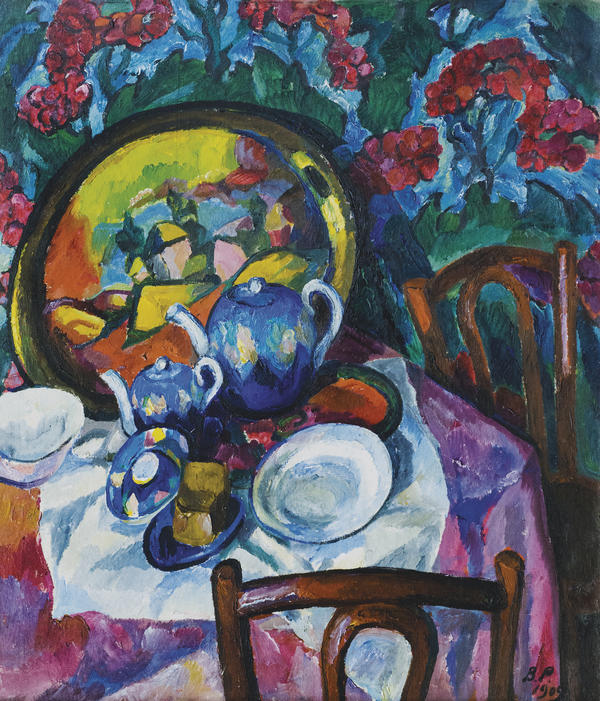Late in 1890s, Vasily Rozhdestvensky, the son of a priest from Tula, decided to give up a theological academy and renounce a career of a clergyman. Like many Russian followers of the avant-guarde movement, he entered the Moscow School of Painting, Sculpture and Architecture, though he never graduated from it since he was expelled for disciplinary violations. It was there that he got acquainted with such painters as Lentulov, Falk, Larionov and Konchalovsky. In 1911, together with them Rozhdestvensky became a cofounder of the Jack of Diamonds group — a seminal alliance for avant-guarde artists. Its foundation symbolized a turning point in painting.
Rozhdestvensky’s works in the museum collection fully express the artistic explorations of the Jack of Diamonds group who rejected academic school of painting and embraced the practices of Сezannism and of latest European trends — Fauvism and Cubism. However, they interpreted the principles of the movements in their own manner, introduced decorative elements and borrowings from Russian primitive folk art. The vanguard artists strived to free painting of literariness coupled with endless philosophic implications and symbols. They aspired to use in full force its basic artistic tools — color, line and plastic means.
Still-life painting was very popular with the artists of the Jack of Diamonds as this genre enabled them to experiment with the mass and volume of objects and to explore synthesis of color and form along with spatial concepts and use of the texture of painterly surface. Much of their still — life painting resembled Henri Matisse’s pictures who had a great impact on the painters as well as Paul Cezanne.
Late in 1890s, Vasily Rozhdestvensky, the son of a priest from Tula, decided to give up a theological academy and renounce a career of a clergyman. Like many Russian followers of the avant-guarde movement, he entered the Moscow School of Painting, Sculpture and Architecture, though he never graduated from it since he was expelled for disciplinary violations. It was there that he got acquainted with such painters as Lentulov, Falk, Larionov and Konchalovsky. In 1911, together with them Rozhdestvensky became a cofounder of the Jack of Diamonds group — a seminal alliance for avant-guarde artists. Its foundation symbolized a turning point in painting.
Rozhdestvensky’s works in the museum collection fully express the artistic explorations of the Jack of Diamonds group who rejected academic school of painting and embraced the practices of Сezannism and of latest European trends — Fauvism and Cubism. However, they interpreted the principles of the movements in their own manner, introduced decorative elements and borrowings from Russian primitive folk art. The vanguard artists strived to free painting of literariness coupled with endless philosophic implications and symbols. They aspired to use in full force its basic artistic tools — color, line and plastic means.
Still-life painting was very popular with the artists of the Jack of Diamonds as this genre enabled them to experiment with the mass and volume of objects and to explore synthesis of color and form along with spatial concepts and use of the texture of painterly surface. Much of their still — life painting resembled Henri Matisse’s pictures who had a great impact on the painters as well as Paul Cezanne.
Late in 1890s, Vasily Rozhdestvensky, the son of a priest from Tula, decided to give up a theological academy and renounce a career of a clergyman. Like many Russian followers of the avant-guarde movement, he entered the Moscow School of Painting, Sculpture and Architecture, though he never graduated from it since he was expelled for disciplinary violations. It was there that he got acquainted with such painters as Lentulov, Falk, Larionov and Konchalovsky. In 1911, together with them Rozhdestvensky became a cofounder of the Jack of Diamonds group — a seminal alliance for avant-guarde artists. Its foundation symbolized a turning point in painting.
Rozhdestvensky’s works in the museum collection fully express the artistic explorations of the Jack of Diamonds group who rejected academic school of painting and embraced the practices of Сezannism and of latest European trends — Fauvism and Cubism. However, they interpreted the principles of the movements in their own manner, introduced decorative elements and borrowings from Russian primitive folk art. The vanguard artists strived to free painting of literariness coupled with endless philosophic implications and symbols. They aspired to use in full force its basic artistic tools — color, line and plastic means.
Still-life painting was very popular with the artists of the Jack of Diamonds as this genre enabled them to experiment with the mass and volume of objects and to explore synthesis of color and form along with spatial concepts and use of the texture of painterly surface. Much of their still — life painting resembled Henri Matisse’s pictures who had a great impact on the painters as well as Paul Cezanne.



